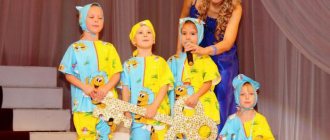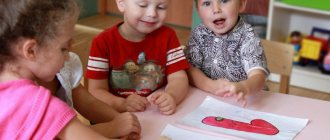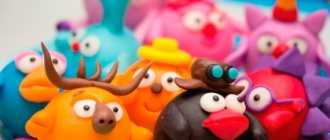Relevance of the problem of speech development
As part of the introduction of the Federal State Educational Standard for preschool education, the requirements for the level of speech development of kindergarten students are being increased as one of the conditions for successful further education at school. The child must be able to use speech as a means of communication, construct a coherent, grammatically correct monologue, and conduct a dialogue.
It is also necessary that he develop phonemic hearing and articulation skills, and form the foundations of intonation culture of speech. The child must have a sufficient vocabulary, be able to perceive texts by ear and retell them.
The problem is that modern children have a deterioration in cognitive and speech development. Therefore, we consider the “Development of coherent speech of children of senior preschool age” to be a relevant topic for self-education.
Self-education plan “Connected speech in the preparatory group”
Academic year: 2017-2018
Relevance.
By the beginning of school, a child must master the entire system of his native language, that is, by the age of seven he must have a sufficient level of development of vocabulary, grammatical structure of speech, phonetic-phonemic side of language activity, coherent dialogical and monologue speech.
Full command of the native language in preschool age is a necessary condition for solving the problems of mental, aesthetic and moral education of children in the most sensitive period of development.
At preschool age, the child masters, first of all, dialogical speech, which has its own specific characteristics, manifested in the use of linguistic means, which is built according to the laws of the literary language. Only special speech education allows a child to master coherent monologue speech, which is an expanded statement consisting of several sentences, divided according to the functional-semantic type into description, narration, and reasoning.
The development of coherent speech is realized through various organizational forms of work: classes (individual, subgroup, group), games (educational, generalizing, cognitive, developmental, productive, communicative, creative, subject, plot, role-playing, verbal and active, etc.) integrated classes.
The formation of coherent speech, the development of the ability to construct a statement meaningfully and logically is one of the main tasks of a child’s speech development.
Target:
increasing your theoretical level, professional skills and competence.
Tasks:
development of free communication with adults;
– improve the dialogical form of speech.
-develop a monologue form of speech;
– learn to retell short tales and stories coherently, consistently and expressively;
– teach (according to a plan and model) to talk about the subject, the content of the plot picture; compose a story based on pictures with sequentially developing events;
– develop the ability to compose your own stories from personal experience.
Self-education plan for the 2017-2018 academic year.
| Month | Subject | The content of the work | Practical solution |
| September October | "Development of coherent speech in the preparatory group" | Selection and study of literature on the topic; didactic games and exercises; plot paintings. | Information stand for parents “Child’s speech as a means of communication” |
| November | Speech development using didactic games. | Clarifying knowledge about activating and enriching children's vocabulary through didactic games. | Consultation for parents on the topic: "Didactic game as a means of connected speech." Card index of didactic games for studying with children Sharing experience with colleagues. Showing a lesson for parents. (11/17/2017) GCD on the topic “Family” |
| December | The influence of Russian folk tales on the development of coherent speech in preschool children | Teaching children to listen carefully to the teacher; see and highlight the positive and negative features of fairy tales and the heroes of these fairy tales; learn to answer the teacher’s questions about the content of the fairy tale. Help children imagine their own position in choosing the method of implementing actions, the image of a literary character; encourage the ability to expressively convey emotional states in facial expressions and movements; develop the ability to compose verbal descriptions based on the perception of pantomimic sketches; activate phraseological units in speech. | Consultation for preschool teachers “Fairytale therapy” in speech development classes.” Creation of a homemade book by children and a teacher based on Russian folk tales. |
| January | Games and exercises for the development of speech in children of senior preschool age. | Improve speech hearing, consolidate the skills of clear, correct, expressive speech. Differentiation of sounds, words, sentences. Practice tempo, voice strength, diction. | Offer parents a card index of games for the development of connected speech: “Find a place for the picture” "Good bad" “Where is the beginning of the story?” |
| February | Work on compiling stories based on plot paintings. | Teach children to look at a picture and highlight its main characteristics; teach children to do research when looking at a picture; form analysis, synthesis; teach children to compose a coherent story based on the picture based on the teacher’s example. Replenish and activate children's vocabulary. | Conversations with parents about the important role children’s stories from personal experience play in the development of coherent speech, and how important it is to listen patiently and carefully to the child when he shares his impressions with you. |
| March | Development of coherent speech through theatrical activities. | Studying methodological literature about theatrical activities in kindergarten, developing children’s creative independence, developing expressiveness in speech; develop the creative abilities of preschool children. | Showing a fairy tale for children of the younger group. "Swan geese " |
| April | Joint creativity of children and parents | Development of creative independence, aesthetic taste, image transmission; Development of emotional speech. Unlocking children's creative abilities. | Family competition “Make a riddle - draw a solution.” |
| May | Preparing for summer health work. | Teach children to compose a fairy tale using a model - diagram; tell each other your fairy tales consistently and coherently; learn to come up with a title for a fairy tale; work on the dictionary - learn to select attributes of objects (adjectives to nouns); cultivate interest in fairy tales and their writing. | Studying methodological and fiction literature, as well as Internet resources on the topics: “Summer”, “Russian folk tales” |
List of used literature:
1. Bazik I. Ya. Development of the ability for visual spatial modeling when familiarizing children of senior preschool age since 1986.
2. Vachkov I.V. Fairy tale therapy: Development of self-awareness through a psychological fairy tale. M. 2001.
3. Lapteva G.V. Games for the development of emotions and creativity. Theater classes for children aged 5 – 9 years. – St. Petersburg. speech; M. Sfera, 2011.
4. Lebedeva L.V. Kozina I.V. Kulakova T.V. et al. Lesson notes on teaching children retelling using support diagrams. Senior group. Educational and methodological manual. – M. Center for Teacher Education. 2009.
5. Shorokhova O. A. Playing a fairy tale. Fairytale therapy and classes for the development of coherent speech in preschoolers. – M. Sphere shopping center. 2007.
6. Ushakova O. S. Program for the development of speech for preschool children in kindergarten. M. 1994.
7. Ushakova O. S. Development of speech and creativity of preschool children. Games, exercises, lesson notes. – M. TC Sfera, 2007.
8. Ushakova O. S. Gavrish N. V. Introducing preschoolers to fiction: Lesson notes. M, 1998.
Goals and objectives
The purpose of working on this topic is:
- increasing the theoretical and practical level, competence and professional skills;
- systematization of work on speech development in preschoolers in accordance with the Federal State Educational Standard.
To achieve these goals, it is necessary to solve a number of problems:
- study modern scientific, methodological, reference literature, periodicals on speech development in preschool children;
- develop a long-term plan for the implementation of a problematic topic;
- choose the most effective methods and techniques, didactic games for the development of speech in children;
- determine ways to involve parents in working on speech development;
- conduct diagnostics among children to determine the effectiveness of the applied work system;




